
12-7 #Optimized : Qualcomm could increase the price of the 2025 flagship chip by a “significant” amount; Apple is betting that its upcoming in-house 5G modem; TSMC has successfully conducted a trial chip production of its 2nm N2 process with a 60% yield rate; etc.

Qualcomm could increase the price of the 2025 flagship chip by a “significant” amount. The chip has been dubbed the Snapdragon 8 Elite “Gen 2”, with the report alleging that “various internal and external factors” are the situation’s primary catalyst. It seems like OEMs and suppliers will feel this price hike first as the alleged report states such suppliers will “raise base prices” or enter “intense” negotiations. (Android Central, KI Post, Twitter, Android Police, Weibo)
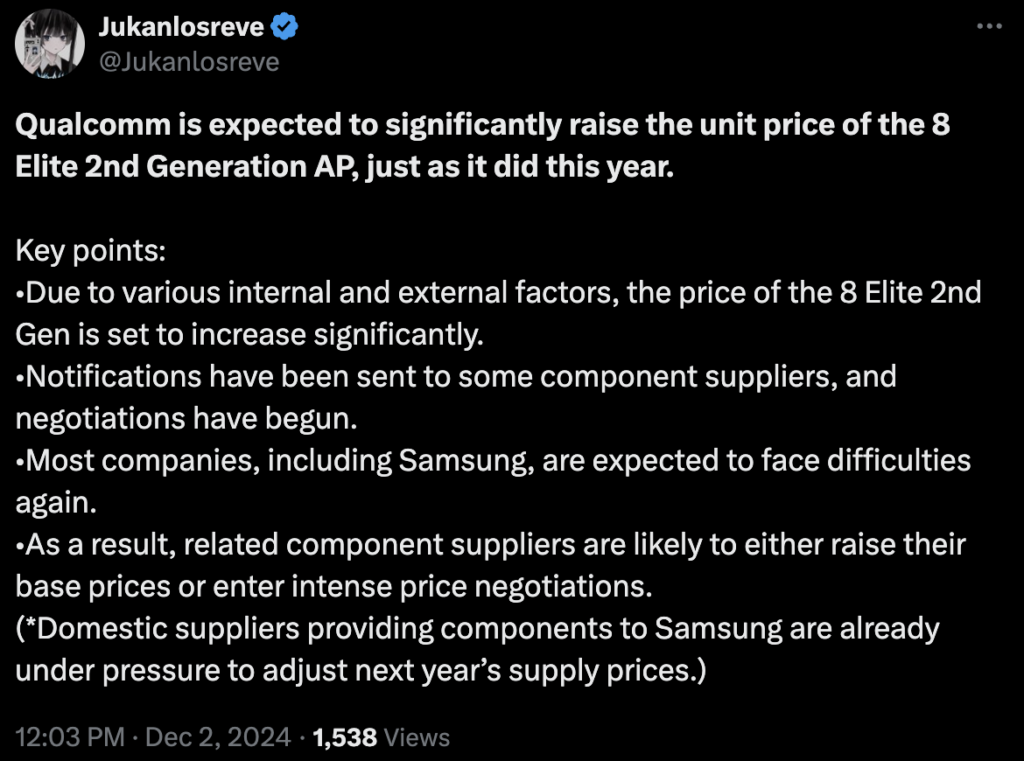
Apple is betting that its upcoming in-house 5G modem could help it beat Qualcomm’s performance eventually, according to Bloomberg’s Mark Gurman. Apple has worked on developing its own modem for years, but the initiative reportedly experienced technical issues and other setbacks despite purchasing Intel’s modem unit in 2019. The first Apple modem is rumored to come to the iPhone SE before appearing in the rumored iPhone “Slim” and entry-level iPads. Down the line, Apple is reportedly planning to roll out a second-generation modem with mmWave in 2026, putting it in the iPhone 18 line and higher-end iPads. In 2027, Bloomberg reports that Apple “hopes to top Qualcomm” with its “Prometheus” modem, which could support AI features and “next-generation satellite networks”. (Bloomberg, The Verge, Android Headlines, Apple Insider)
Apple’s effort to build its own modem technology will set the stage for a range of new devices, starting with slimmer iPhones and potentially leading to cellular-connected Macs and headsets. The new products will be made possible by an in-house modem chip slated to debut in 2025. the modem, codenamed “Sinope”, which will be more tightly integrated with Apple’s other hardware components. This could result in some obvious benefits including a thinner iPhone. That component, which connects devices to cell towers, will gradually replace parts from supplier Qualcomm during a three-year rollout. (Apple Insider, Bloomberg, BNN Bloomberg, Business Times)

Amazon.com founder Jeff Bezos joined Samsung in a USD700M bet on Tenstorrent, valuing the AI chip startup with ambitions of taking on Nvidia at about USD2.6B. The money will be used to build out Tenstorrent’s engineering team, invest in its global supply chain and build large artificial intelligence training servers to help demonstrate its technology. (Android Headlines, Bloomberg, Yahoo)

TSMC has successfully conducted a trial chip production of its 2nm N2 process with a 60% yield rate. TSMC has achieved better than anticipated results with its trial production run at its Baoshan facility in Hsinchu County, Taiwan. Following the successful trial production run, TSMC is set to begin mass-producing its 2nm chips at its facility in Kaohsiung, Taiwan, in 2025. Apple and Nvidia are expected to be amongst the first companies to procure chips fabbed on TSMC’s N2 node. Chips fabbed on TSMC’s 2nm process are likely to cost twice as its 4nm and 5nm chips, with rumored pricing of USD30,000 per wafer. (UDN, LTN, GSM Arena)

Broadcom announced the availability of its 3.5D eXtreme Dimension System in Package platform technology, enabling consumer AI customers to develop next-generation custom accelerators. The 3.5D XDSiP integrates more than 6000 mm2 of silicon and up to 12 high bandwidth memory stacks in one packaged device to enable high-efficiency, low-power computing for AI at scale. Broadcom has achieved a significant milestone by developing and launching the industry’s first Face-to-Face 3.5D XPU. The 3.5D XDSiP provides significant enhancements in signal density, power efficiency, and reduced latency by leveraging advanced 3D stacking and optimized interconnect technologies. As Broadcom collaborates with partners like TSMC and Fujitsu, the platform is set for production shipments starting Feb 2026, marking a crucial development in the evolution of high-performance computing. (CN Beta, Broadcomm, Business Insider)

Founded in 2017, Axiado makes chips to secure devices ranging from data centers to 5G base stations. Axiado’s chip aims to protect against boot-level attacks by authenticating boot-level updates before they’re executed, and by regularly checking the integrity of the boot sequence. Sirineni claims that this prevents boot-level attacks from penetrating systems in which Axiado’s chip is installed. The chip also handles runtime security, security for software, apps, and workloads post-boot. In this way, it’s comparable to chips like Microsoft’s Pluton, Google’s Titan, and Apple’s T2. The company CEO Gopi Sirineni says that Axiado’s chip employs root-of-trust technology, which cryptographically protects against hardware tampering. In addition, the chip drives Axiado’s cybersecurity monitoring platform, which tries to detect potentially malicious activity in data patterns. (CN Beta, TechCrunch, KED Global, Forbes, Axiado)

Tsinghua Unigroup’s chip subsidiary Unisoc announced plans to secure an additional CNY2B (USD448M) in equity financing, following its earlier CNY4B (USD896M) round. The new investment round, led by Yuanhe Puhua and its founder Chen Datong, aims to accelerate advancements in 5G, satellite communications, automotive electronics, and smart wearables while attracting top-tier talent. Chen, a returning strategic advisor and Spreadtrum Communications founder, emphasized Unisoc’s critical role in China’s 5G chip ambitions, declaring, “Unisoc must excel and cannot fail”. (CN Beta, EET-China, Digitimes)


DSCC’s latest report on the foldable and rollable / slidable display market for all display applications shows that the foldable smartphone market has stalled. After enjoying at least 40% growth per year from 2019-2023, DSCC now believes the foldable smartphone display market will rise just 5% in 2024 and fall by 4% in 2025. Demand has stalled at around 22M panels. Foldable smartphone display procurement was down 38% YoY in Q3’24 and is expected to be down YoY in 4 of the next 5 quarters. Apple is expected to enter the foldable market in 2H26 and given their dominant position in flagship smartphones could generate significant growth for the foldable smartphone market. Any improvement in form factor, functionality, use cases, durability, etc. could drive new demand for this market. As a result, 2026 is expected to be a record year for foldables with over 30% growth and with over 20% growth projected for 2027 and 2028 as well. In addition, we expect at least one other brand to adopt a tri-fold in 2026 and expect to see the first slidable laptop in 2025 with more models coming in 2026. In 3Q24, the top 10 foldable smartphones on a panel procurement basis included: Three models from Samsung including the top 2 with the Z Flip 6 leading with a 31% share; Two models each from Huawei and Motorola and one model each from Google, Honor and Xiaomi. (Android Headlines, Twitter, DSCC)
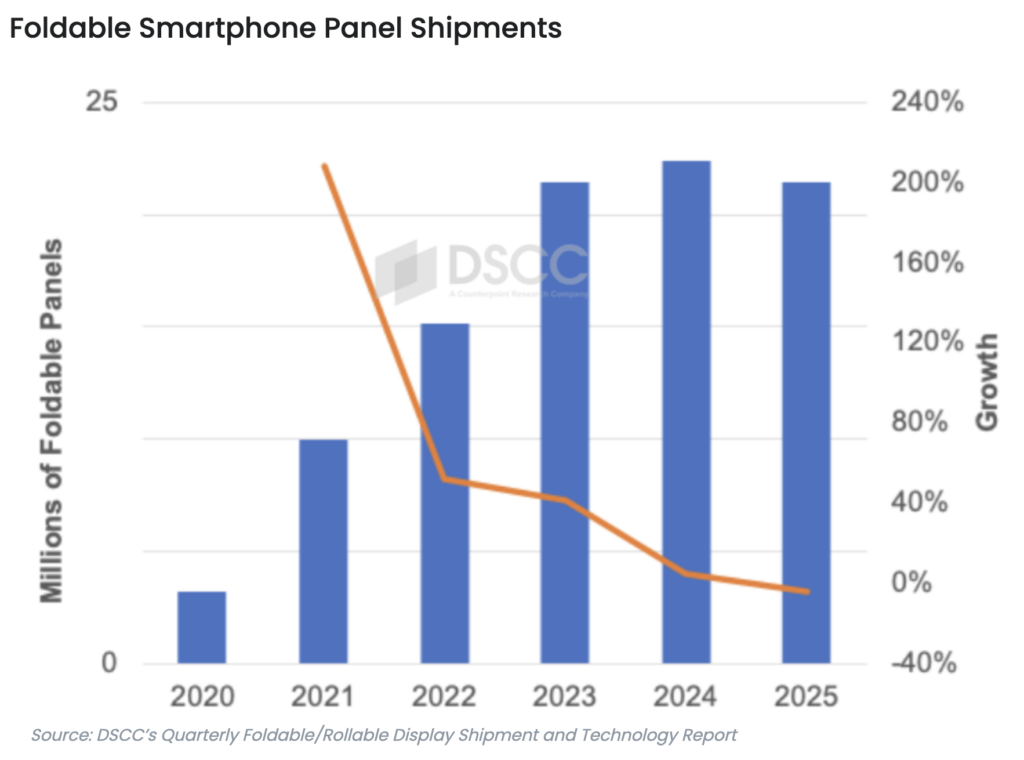
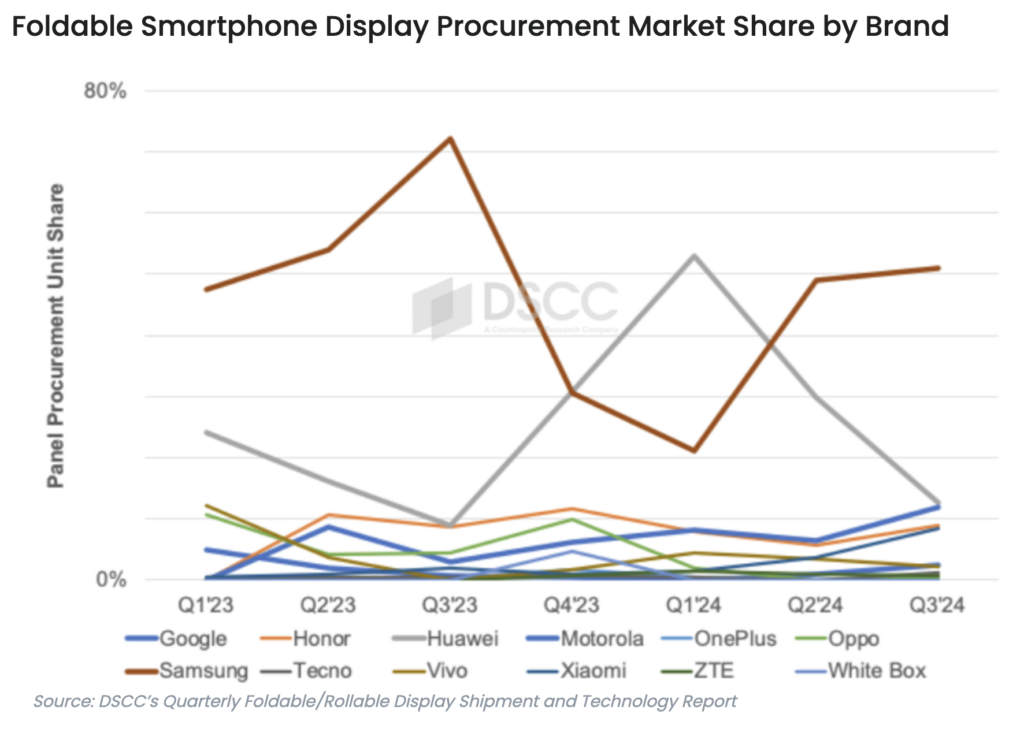
OnePlus has launched an innovative solution to tackle a common issue many smartphone users face: the appearance of green lines on AMOLED displays. This problem, particularly prevalent in India due to environmental conditions, has prompted OnePlus to create the “OnePlus Green Line Worry-Free Solution”. With this initiative, the company combines cutting-edge display technology, thorough quality control, and an impressive lifetime warranty to ensure users feel confident in their devices. The Green Line Worry-Free Solution revolves around three main pillars, each designed to address the causes of green lines and give users peace of mind when it comes to their smartphone displays. With the new ‘Worry-Free Solution’, the company will adapt to advanced display technology, stringent quality control, and extends its lifetime warranty. The company will integrate an Enhanced Edge Bonding Layer, which is claimed to utilise superior PVX edge-sealing materials in all OnePlus phones with AMOLED displays.(GSM Arena, Mashable, 91Mobiles)

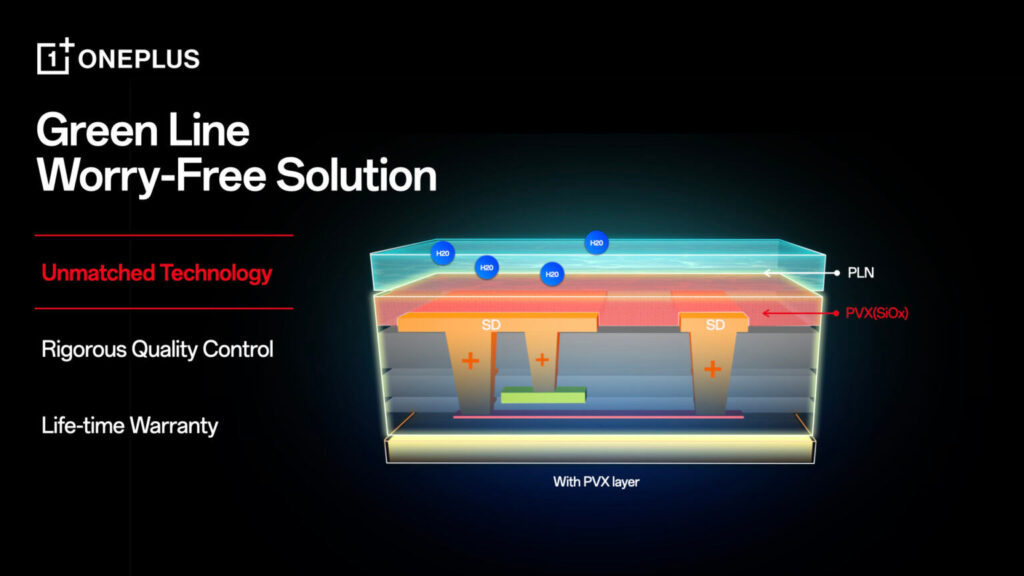

Tecno has showcased TECNO Image Matrix (TIM), which is a new AI imaging “brain” that restructures and optimizes power to enhance imaging processes, power new and optimized imaging functions and create more exceptional images. The new matrix is based on the optimization of the data pipeline with newly upgraded TAPS (TECNO Algorithm Process Stack) underlying architecture as the technical foundation. It builds a fully intelligent process from image capture to post-processing, aiming to significantly improve the efficiency and quality of image processing, and provide global users with an excellent shooting experience and professional-level image output. Meanwhile, EVS Dynamic Shot technology perfects capture of subjects in motion, and Tap Any Zoom Dual Prism Telephoto enables more stable long-range shooting. EVS Dynamic Snapshot technology overcomes the limitations of traditional snapshot methods and the light intake constraints of compact cameras to enhance the camera’s ability to capture motion. (Android Headlines, PR Newswire)


SK Hynix plans to produce its sixth-generation high-bandwidth memory (HBM4) chips using TSMC’s 3nm process technology. These chips are slated for delivery to Nvidia in 2H25. SK Hynix initially intended to use a 5nm process for HBM4 production. However, due to major customer demands for more advanced memory, the company shifted to the 3nm process, with shipments to NVIDIA expected in 2H25. SK Hynix’s prototype HBM4 chip, unveiled in March, features vertically stacked dies on a 3nm base die. Compared to 5nm base dies, the 3nm-based HBM chips are expected to deliver a 20–30% performance boost. However, SK Hynix’s general-use HBM4 and HBM4E chips will utilize a 12nm process in collaboration with TSMC. SK Hynix’s fifth-generation HBM3E chips rely on its own base die technology, but the company has opted to use TSMC’s 3nm technology for HBM4. (CN Beta, TrendForce, KED Global)


SpaceX received a Pentagon contract to expand Ukraine’s access to a more secure, militarized version of its Starlink satellite network, deepening the company’s involvement in the conflict despite founder Elon Musk’s ambivalence over the war. The contract means that 2,500 Starlink terminals already in Ukraine will get access to Starshield, a classified and encrypted signal over Starlink that’s more difficult to hack into or jam. That number is in addition to the 500 that were previously connected to Starshield. “A total of 3,000 terminals are provided service via the two contracts,” according to a statement to Bloomberg News from the Space Systems Command’s Commercial Satellite Office. The contracts share a common purpose “to facilitate internet connectivity in Ukraine,” it said. “Both provide service into 2025”. (CN Beta, CNBC, Bloomberg, BNN)

China Unicom announced the launch of its new international brand, UniCom. UniCom aims to work hand in hand with global partners through unique innovative products and services to achieve the vision of united development. Com stands for Communication, Computation and Community. China Unicom insists on innovation-driven development, based on the resource endowment of network communication (Communication), using the strengths of the network to strengthen the foundation of connection; giving full play to the advantages of the integration of computing, network, and intelligence (Computation), using the power of data to increase the intelligence of applications, building a global cooperation (Community) ecosystem, and improving service efficiency with the power of collaboration. (CN Beta, Sina, AAStocks)


A new Samsung patent describes a new detachable strap mechanism for Galaxy smartwatches. The new strap system seems to consist of: Core: The core consists of a piece that stays in place (called the first fastening portion) and the other piece can move relative to the first piece (also called the second fastening portion). Strap: The strap is a seamless piece consisting of two band halves and a frame that connects to the core. From the design, it appears that the user can place the strap piece over the core to connect both parts. So, it can also be detached if needed. Grooves: The strap seems to be connected to the core using grooves (hollow cutouts) and fastening portions. (Android Headlines, 91Mobiles)


Samsung could finally showcase its extended reality (XR) smart glasses alongside the Galaxy S25 series in Jan 2025. Samsung will allegedly unveil the prototype of its XR device early 2025. The wearable might not launch before 3Q25.The device will purportedly resemble regular glasses and weigh around 50g. Samsung has seemingly been working with Google and Qualcomm to develop these smart glasses since Feb 2023. (Yonhap News, SamMobile, Android Headlines, Yahoo, Twitter)


Google is introducing GenCast, a “high resolution AI ensemble model”. GenCast is a diffusion model, similar to those you may have seen in AI image generators. However, this one is tuned specifically for Earth’s geometry. It was trained on four decades of historical data from ECMWF’s archives. To test it, Google trained GenCast on historical weather data up to 2018 and ran 1,320 different forecasts for 2019 and compared its output against ENS and the actual weather. GenCast was more accurate than ENS in 97.2% of cases, going up to 99.8% more accurate for forecasts for 36 hours ahead or longer. (GSM Arena, Google, Nature)
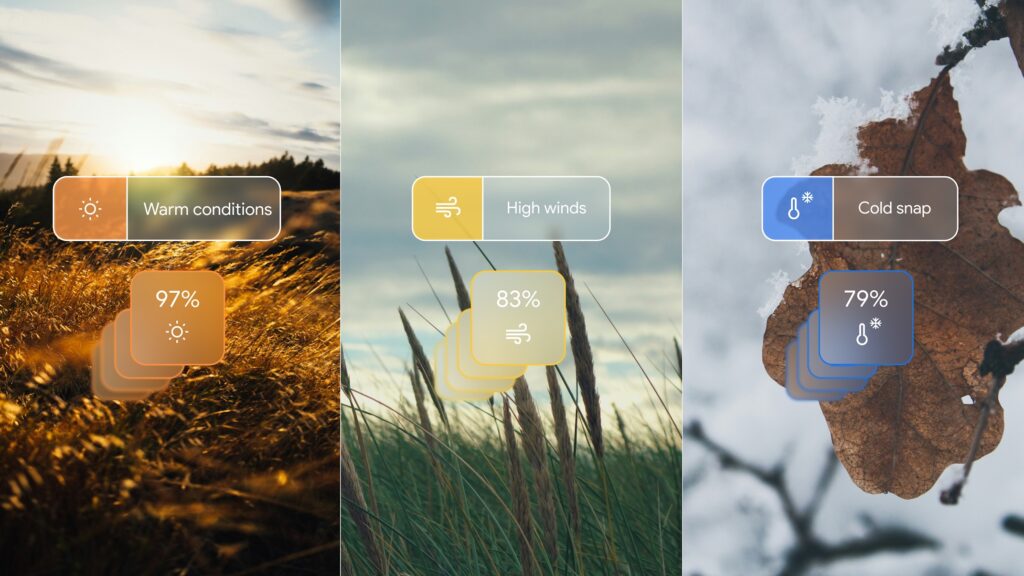
Apple and Baidu are working to add AI features to iPhones sold in China, but are facing hurdles that could hurt the tech giant’s phone sales in the country. The companies, which are adapting Baidu’s large language models for iPhone users, are grappling with issues such as the LLMs’ understanding of prompts and accuracy in responding to common scenarios. Apple’s privacy policies do not allow collection of data from iPhone users who make AI-related queries, but Baidu wants to save and analyse this data. Baidu’s most advanced model, Ernie 4.0, is being employed as the foundation for Apple’s genAI services on the iPhone, Mac and iPad. Siri will also use Baidu’s AI models. (GSM Arena, The Information, Reuters)

Meta has announced the newest addition to its Llama family of generative AI models: Llama 3.3 70B. Ahmad Al-Dahle, VP of generative AI at Meta, said that the text-only Llama 3.3 70B delivers the performance of Meta’s largest Llama model, Llama 3.1 405B, at lower cost. Al-Dahle published a chart showing Llama 3.3 70B outperforming Google’s Gemini 1.5 Pro, OpenAI’s GPT-4o, and Amazon’s newly released Nova Pro on a number of industry benchmarks, including MMLU, which evaluates a model’s ability to understand language. Via email, a Meta said that the model should deliver improvements in areas like math, general knowledge, instruction following, and app use. Llama 3.3 70B, which is available for download from the AI dev platform Hugging Face and other sources, including the official Llama website, is Meta’s latest play to dominate the AI field with “open” models that can be used and commercialized for a range of applications.(CN Beta, TechCrunch, Together.ai)

Google is introducing PaliGemma 2 as its latest open vision-language model (VLM). The first version of PaliGemma launched in May 2024 for use cases like captioning images and short video, understanding text in images, object detection, object segmentation, and “visual question answering”. PaliGemma 2 now touts “long captioning” with the ability to generate “detailed, contextually relevant captions for images, going beyond simple object identification to describe actions, emotions, and the overall narrative of the scene”. Available model sizes include 3B, 10B, 28B parameters, as well as 224px, 448px, and 896px resolutions. There is also “accurate optical character recognition and understanding the structure and content of tables in documents”. Google has found PaliGemma 2 to offer leading performance in chemical formula recognition, music score recognition, spatial reasoning, and chest X-ray report generation. (CN Beta, Google, TechCrunch, 9to5Google)

Amazon Web Services (AWS), Amazon’s cloud computing division, announced a new family of multimodal generative AI models it calls Nova. There are four text-generating models in total: Micro, Lite, Pro, and Premier. Micro, Lite, and Pro are available to AWS customers, while Premier will arrive in early 2025, says Amazon CEO Andy Jassy. In addition to those, there is an image-generation model, Nova Canvas, and a video-generating model, Nova Reel. (CN Beta, TechCrunch, Amazon, AWS)
